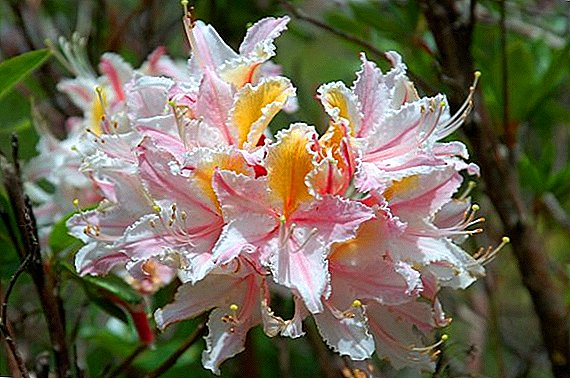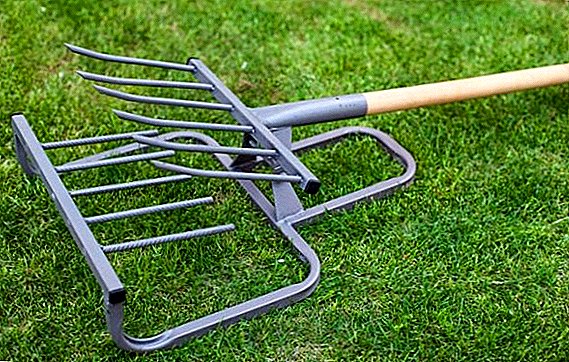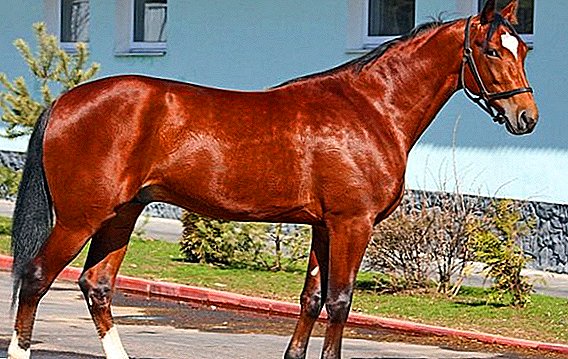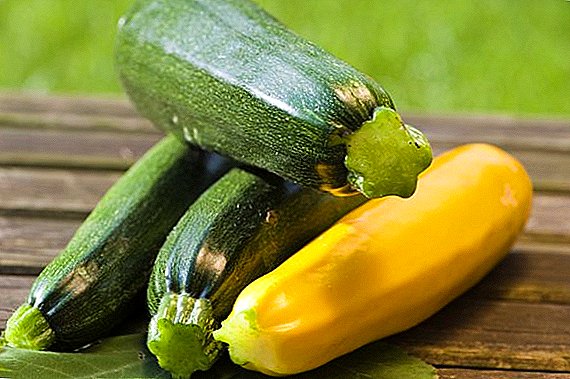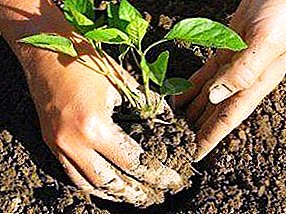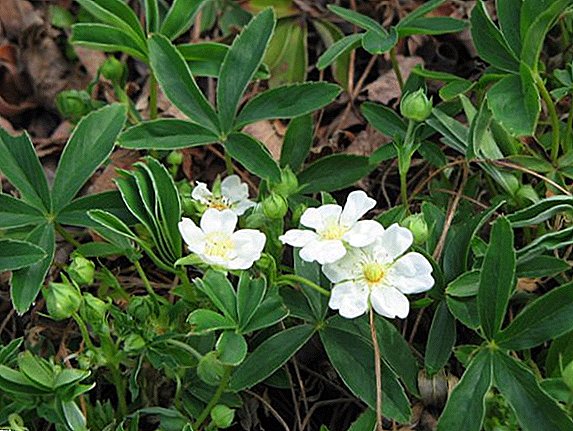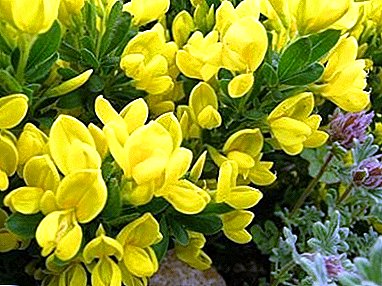
By the genus Rakitnik carry about fifty shrubs and small trees that can be found in Europe, Africa and Western Siberia.
They are widely used to decorate sand slopes, as well as grown as ornamental shrubs in groups and singly.
General description of the plant
Broom is a shrub that is great honey plantwhich can reach a height of two and a half meters. Its stems can be smooth and bright green, and can be pubescent and silvery.
He begins to bloom in spring and summer, and the color of its colors can be like white yellow or creamso and lilac or scarlet. Flowers, resembling pea flowers in their shape, are located on the limbs of the shoots or in the axils of the leaves. In some varieties of broom, flowers have a very pleasant aroma.
Kinds
Blotsky Broom - Chamaecytisus blockianus
This is a rather rare endemic species that is listed in the Red Book in Ukraine. It can also be found in the European part of Russia. It grows among other shrubs and is located in the undergrowth of well-lit forests.
In height, the broom can grow up to forty centimeters. Until such a size, it grows in two to three years. Blossom begins in early July and blooms for about a month, attracting attention bright yellow flowers. In the first decade of October the ripening of the fruits of this shrub occurs.
Bark naked extended - Chamaecytisus glaber var. elongatus
This species usually grows on the mountain slopes in the southeast side of Western Europe. Its height is about one and a half meters. The growing season at the above-mentioned shrub tends to begin at the end of the first decade of April and ends in mid-October.
He gains growth quite quickly, and begins to bloom upon reaching three or four years of age. The flowers are yellow in color., and the fruits become mature in September.
Broom lying - Chamaecytisus supinus
The homeland of this plant is South and Central Europe.
The vegetation processes in it continue from the last days of April to mid-October. Tall bush can reach from fifty to one hundred centimeters.
Grows at an average speed, and begins to blossom and bear fruit on attaining three years of age. Flowering lasts about forty-five days.
It begins in mid-June and ends in late July, and by the end of September the fruits ripen.
Podolsky broom - Chamaecytisus podolicus
Broom Podolsky distributed in Ukraine and in the European part of Russia. Most often he chooses the dry slopes of limestone as his habitat. In height, this variety usually reaches fifty centimeters, but in Moscow you can find specimens that have reached one meter. The diameter of their crown is approximately two meters.
The flowering period of this plant runs from the second half of June to September, and fruit can ripen from August to October.

Purple Broom - Chamaecytisus purpureus
This variety can be found in the thickets of shrubs that have chosen the mountain slopes in South and Central Europe. it creeping shrubwhich usually reaches sixty centimeters in height. It can be recognized by the spreading crown of greenish color, consisting of raised branches, which are densely covered with triple leaves with slices in the shape of an ellipse. It reaches its height for three to four years.
The shoots of this representative of wildlife can be seen at the end of May or in June, and the period of their growth runs until October. In winter, shrub frosting to the mark on which there is snow cover. is he prefers well lit places and high carbonate soil.
This purple beauty begins to bloom in the fifth to sixth year of its life. Its charming flowers delight the eye every year from the end of May to the end of June. The plant begins to bear fruit from the age of five, the fruits reach maturity in the last days of August or in the first week of September. The vegetation period starts in May and lasts one hundred and sixty-three days.
Regensburg broom - Chamaecytisus ratisbonensis
This species lives in the southern region of Western Europe and in the basin of the Dnieper River in Ukraine among other shrubs or in coniferous forest belts.
Up he grows up to thirty centimeters. The shoots of the Regensburg broom are covered with silver-colored fluff and triple leaves.
Moth flowers bright sunny color with a brown speck on a vertical petal placed on the shoots of the last year in the leaf axils and connected in one-sided brushes, similar to the scallops.
Flowers keep at this plant from fifteen to twenty two days. Its fruits are beans measuring about three centimeters.
This plant is different remarkable frost resistance and light loving. Relatively easy to tolerate dry weather.
Roshal Broom - Chamaecytisus rochelii
Roshal broomstick spread in the European Balkans, as well as on the edges of coniferous forests west of Ukraine. It grows to a height of fifty to ninety centimeters and has scattered shoots covered with leaves with three dense oval-lanceolate slices, on which red hairs are two and a half centimeters in size.
Flowers and fruits begin to appear in the bush when he is six years old. The flowering period begins in June and lasts about a couple of weeks. The flowers have a pale yellow colorand their length is fifteen millimeters. They gather in inflorescences.
Fruit ripening can be observed in the third summer month. They are sickle pubescent beans.
For such a shrub is best suited sandy and stony ground. He loves sunshine and no problem. endures drought.
Broom Russian - Chamaecytisus ruthenicu
This species is most common. in the Caucasus and in the west of Siberiaand also in the steppes and forest-steppes of the European regions of the Russian Federation.
It can grow both on stony slopes and in forest glades. In addition, it creates undergrowth in coniferous forests, settling in poor sandy soil.
Its height is usually about one and a half meters. It is characterized by the presence of smooth or curved grayish branches and shoots with a silky edge.
The branches are equipped with trifoliate leaves with lanceolate-elliptical lobes topped with a thorn. The color of the outer side of the leaves has a gray-green color. Their inner side is densely covered with hairs.
In the axils of the leaves can be seen from three to five yellowish flowers of impressive size. Flowering lasts twenty-five days.
The fruits are flat beans, the length of which does not exceed thirty millimeters. They reach maturity in the first month of autumn. The color range of beans can be dark gray or black. From above they are covered with grayish hairs. Inside the fruit you will find flat shiny grains, the length of which is three millimeters, with a characteristic green or yellow color.
NOTE another two bushy plants like broom growers: Skimmy and Leptospermum. They can also be a decoration for your home or garden.
Home care
Care after purchase
If you decide to purchase a broom, you should pay attention only to those seedlings that were grown in pots or containers.
Old seedlings of large sizehaving a bare root system should not buy, because they will get used to an unfamiliar place for too long or may not take root at all.
Select in advance for your new tenant a plot with as much light as possible, as it relates to light-loving plants. The place for its placement must be securely covered from frost and strong wind. It will be best to feel it in weakly acidic soil, which easily passes moisture.
IMPORTANT! When purchasing a new pet for yourself, carefully look at it for pests and signs of fungal diseases. After bringing the plant home, spend it just in case treatment with a fungicide.
Pruning
 Pruning the broom is done after it fades.
Pruning the broom is done after it fades.
Last year's shoots are cut to half of their growth.
This manipulation stimulates the emergence of fresh shoots, on which flowers will appear next year.
IMPORTANT! When pruning shoots, try not to touch those parts of the branches that have managed to lumber.
Watering
Spring and summer watering bushes should be enough plentiful and be made immediately after drying topsoil. In autumn and winter, they should be watered sparingly, since excessive soil moisture will lead to souring. For watering get used to use the water, which includes lime.
Landing
Planting breeches should be carried out in the soil, which consists of one part of turf soil, one part of humus and two parts of sand. Mineral fertilizer should be immediately applied to the soil.
The best time for planting seedlings is spring. The diameter of the pit should be twice the size of the earthen coma, which is located on the rootstock of the seedling. The distance between the landing pits should be from thirty to fifty centimeters.
At the bottom of the pit is necessarily placed drainage, consisting of sea pebbles or brick fragmentswhose layer should be about twenty centimeters thick.
Drainage is poured on the ground until its level is equal to the upper boundary of the earthen clod with its roots. After that, around the plant should be poured more earth and ram it. Do not forget to make a recess for watering. After planting the seedling requires abundant watering.
Transfer
As an adult, broom transplant does not tolerate, so if there is a need for this procedure, then it should be done at a young age.
IMPORTANT! At the roots of this representative of the flora, you can see the tubers that you do not need to delete when transplanting. They accumulate nutrients.
Growing from seed at home
 If you want to independently grow a broom, from seeds, they can be harvested from mature beans in August or September.
If you want to independently grow a broom, from seeds, they can be harvested from mature beans in August or September.
To plant seeds, prepare containers that need to be filled with sand or a special soil mixture.
To obtain it is required to mix peat and sand in equal parts.
Seeds need to be deepened into the ground by five to six millimeters. After planting the seeds, place the container in a dark place, air temperature in which will remain within between nineteen and twenty one degrees of heat. Seed containers need regular spraying and airing.
When the seeds sprout, they must be separately dive into pots, the height of which should be seven centimeters. Fill the pots with a mixture of one part of the humus, one part of the sand and two parts of the soddy earth.
With the arrival of spring, the seedlings should be transplanted into pots with a height of eleven centimeters and pinch them so that they begin to branch out.
Breeding
There are such methods of reproduction of this representative of the plant world:
- seeds;
- layering;
- cuttings.
When the fruits on the bushes finally ripen, they open and throw out a huge number of seedswhich, without any help, sprout around the bush. When the leaves appear on these shoots, you can transfer them to another place.
To obtain layers, it is necessary to bend the branches of an older bush and place them in previously prepared holes, then sprinkle them with earth.
Cuttings broom made in the first months of summer. Cut a little lignified cuttings twenty centimeters long, leave three or four leaves on them and plant them in containers filled with moistened peaty-sandy mixture.
Cover the boxes with a transparent film of polyethylene and wait for about one and a half months until the cuttings take root. Store the boxes in a room where the temperature of the air is kept at a mark of plus twenty degrees.
NOTE! Perhaps you will be interested in unusual flowers from the category of decorative leaves, such as: amazing Strobilantes, unusual Kufeya, luxurious Caladium.
Temperature
 During the spring-summer period, the most preferred air temperature for a broom is eighteen-twenty-five degrees above zero.
During the spring-summer period, the most preferred air temperature for a broom is eighteen-twenty-five degrees above zero.
In November, it plunges into a period of rest, which runs until February.
At this time, the ambient temperature should be between eight and ten degrees Celsius, since at a temperature above sixteen degrees of heat your pet will start to hurt.
Lighting
Most broom loves a diffused bright light. A small amount of the direct rays of the sun will not hurt him, but in the noontime it is desirable to taper him a little.
If you keep the broom in the room, then it will be best to feel on the windows located on the east or west wall, but you can also put it on the south or southeast windowsill.
Benefit and harm
IMPORTANT! Growing broom, do not forget that this plant is poisonous. But despite this, it has some healing properties.
So, Russian warrior boasts high content of flavonoidsable to excrete chlorine from the body. In addition, they have excellent diuretic effect.
To prepare the tincture or decoction of the Russian breech, you will need to collect the upper branches of the bushes covered with young flowers immediately after flowering. The received medicine is recommended to be used by the persons suffering cholecystitis, hepatitis, angina or migraine.
Diseases and pests
 Broom is different good resistance to pests and diseases.
Broom is different good resistance to pests and diseases.
Sometimes it can be attacked by a broom sack moth, which can be very easily destroyed by spraying the plant with 0.2% chlorophos.
You can cope with the broom moth using organophosphate or bacterial insecticides, as well as their combinations.
When it is found on the leaves of powdery mildew, it is necessary to treat its sleeping buds with a 5% solution of copper sulfate.
Conclusion
With proper care, the broom can become a real decoration of your garden and every year delight your eye with lovely fragrant flowers.





